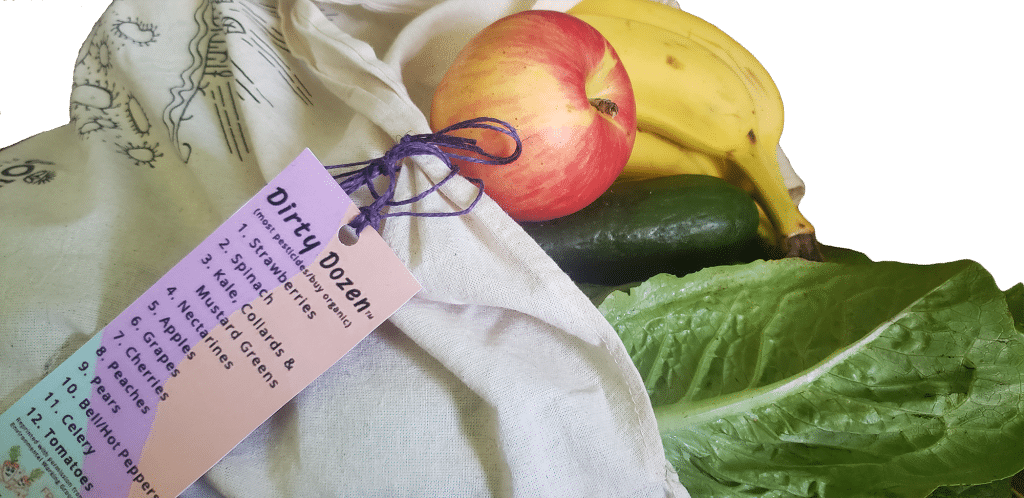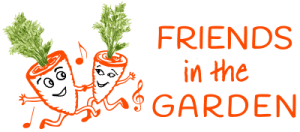
Probably the only way you can avoid exposure to pesticides and other environmental toxins is to have been cryogenically frozen since…hmmm, okay, it’s probably unavoidable. But, you can reduce your pesticide intake from food, and it’s not difficult or prohibitively expensive to do. This article outlines easy ways to consume fewer pesticides without breaking the budget.
The quickest way to start consuming fewer pesticides is to use the Environmental Working Group’s (EWG) Clean Fifteen/Dirty DozenTM list as your produce shopping guide. The Dirty Dozen list ranks the top twelve conventionally grown fruits and veggies containing the highest levels of pesticides. EWG relies on USDA data for their analysis and rankings. Note that the USDA doesn’t test for all pesticides, and doesn’t test for the most commonly used pesticide glyphosate (a.k.a. Roundup). Also note that the USDA washes and peels or scrubs the produce prior to testing.
Which foods have the most pesticides?
Reducing your consumption of pesticides means you have to first know where they are showing up in your groceries. We are all told that eating more fresh fruits and vegetables is the fast track to better health. We are told that children especially need the nutrients and fiber that fruits and vegetables offer. What we are not told is that veggies like spinach and kale are no. 2 and no. 3, respectively, on the list of the most toxic and pesticide-laden veggies in the U.S. today. In fact, conventionally grown spinach is heavily laden with pesticides. A 2016 USDA analysis of 642 samples found an average of 7 pesticides on each sample. Think about that – we aren’t just talking about one pesticide leaving residue on your favorite leafy green. There was an average of 7 different pesticides. Let that sink in. NO! Put that conventionally grown leafy green down, keep it away from your mouth and the mouth of anyone you love.
When was the last time you ate at a salad bar or grabbed a to-go salad somewhere, thinking you earned a halo for healthy eating? If it wasn’t organically grown then the spinach, kale and tomatoes in your healthy salad relocated some nasty pesticides to your belly. And have you encouraged your kids to eat their spinach or kale so they could grow strong and healthy? You get the point. This information isn’t common so how would you know?

Strawberries are at the top of the Dirty DozenTM list for 2021. Even after being rinsed after picking and washedbefore testing, the USDA still found from 1 to 22 types of pesticide and breakdown residues in conventionally grown strawberry samples. The residues are linked to cancers, hormone disruption, and neurological effects. Sweet beautiful strawberries. Strawberry jam or jelly, strawberry donuts, strawberry fruit rolls, strawberry ice cream, chocolate covered strawberries – these all pack a good pesticide punch. Sorry! I hate to bring that bad news. Luckily, strawberries are pretty easy to grow and organic frozen strawberries are easy to find. Right now is a good time to commit to only eating and serving organically grown strawberries. Ditto for spinach and kale.
What’s on the rest of the list? Spinach, Kale-Collards-Mustard Greens, Nectarines, Apples, Grapes, Cherries, Peaches, Pears, Bell & Hot Peppers, Celery and Tomatoes. These are all pretty common foods so chances are you’ve been consuming their prospective pesticides for a while if you dine out or buy them non-organically grown. Don’t give up on these foods yet. There are ways to buy safer produce.
Keep it Clean
You know what’s on the Dirty DozenTM list and you’re motivated to reduce pesticide consumption. Now what? The best way to reduce pesticide consumption is to buy organically grown produce. Yes, it is often more expensive. But, go back to the list and remember, you really only have to buy those particular fruits and veggies organically grown. Not all of the produce you buy must be organic, especially if you’re shopping on a budget. That’s why it’s important to have this list – so you know where to focus your money for the best health gains. Consider these ways of procuring Dirty DozenTM produce:
- Buy organic produce at your local grocery store (buy in season, it’s less expensive)
- Buy frozen organic produce when it’s not available fresh
- Buy locally grown produce at a farmer’s market – ask if they use chemical pesticides. Often, locally grown produce is pesticide-free but they haven’t obtained USDA organic certification.
- Grow your own – lucky for us, veggies like spinach, kale and potatoes are easy to grow. Tomatoes and strawberries are also super easy to grow.
These don’t have to be organic
There is another list I mentioned at the beginning of this article. The Clean FifteenTM. Those are the top fifteen fruits and vegetables that are relatively safe to eat when conventionally grown. They have the lowest amount of pesticide residues. In order, starting with the cleanest:
- Avocados
- Sweet corn
- Pineapple
- Onions
- Papaya
- Sweet Peas (frozen)
- Eggplant
- Asparagus
- Cauliflower
- Cantaloupe
- Broccoli
- Mushrooms
- Cabbage
- Honeydew Melon
- Kiwi
 Now you know: how to consume fewer pesticides; when extra spending makes sense (which fruits and veggies must be organic); and when to save money (buying Clean FifteenTM items conventionally grown). The easiest way to use this information is to have these lists attached to your shopping bags. We’ve got you covered – download our complimentary Clean Fifteen/Dirty DozenTM Bag Tags. Get the kids in on making some Bag Tags (included in the download). It’s easy, just print, cut and laminate. Punch a hole at the top and tie them to your favorite shopping bags. Happy Clean Shopping!
Now you know: how to consume fewer pesticides; when extra spending makes sense (which fruits and veggies must be organic); and when to save money (buying Clean FifteenTM items conventionally grown). The easiest way to use this information is to have these lists attached to your shopping bags. We’ve got you covered – download our complimentary Clean Fifteen/Dirty DozenTM Bag Tags. Get the kids in on making some Bag Tags (included in the download). It’s easy, just print, cut and laminate. Punch a hole at the top and tie them to your favorite shopping bags. Happy Clean Shopping!
Now get outside and play,
Maria
